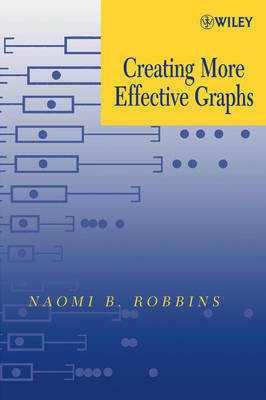
Creating More Effective Graphs
John Wiley & Sons Inc (Verlag)
978-0-471-27402-5 (ISBN)
- Titel ist leider vergriffen;
keine Neuauflage - Artikel merken
Whether you're a novice at graphing or already use graphs in your work but want to improve them, Creating More Effective Graphs will help you develop the kind of clear, accurate, and well-designed graphs that will allow your data to be understood.
NAOMI B. ROBBINS, PhD, is President of NBR, a leader in consulting and training in graphical data presentation. A recognized expert in the field, she has spoken on the subject of creating effective graphs at universities including Columbia University and McGill University, professional societies such as the Society of Women Engineers and the Society for Technical Communication, and corporations and organizations that include Lockheed Martin, Brookfield Zoo, and the United Nations. She is an officer of the Statistical Graphics Section of the American Statistical Association and has served the New Jersey Chapter of the ASA as President. She was a statistician at Bell Laboratories before forming NBR.
Preface. 1. Introduction. 1.1 What we mean by an Efficient Graph. 1.2 General Comments. 1.2.1 Captions. 1.2.2 The Data we Plot. 2. Limitations of Some Common Charts and Graphs. 2.1 Pie Charts. 2.2 Charts with 3-D Effect. 2.3 Bar Charts: Stacked and Grouped. 2.4 Difference Between Curves. 2.5 Bubbled Plot. 3. Human Perception and Our Ability to Decode Graphs. 3.1 Elementary Graphical Perception Tasks. 3.2 Ordered Elementary Tasks. 3.3 Role of Distance and Detection. 4. Some More Effective Graphs in One or Two Dimensions. 4.1 Distribution of One Variable. 4.1.1 Strip Plots. 4.1.2 Dot Plots. 4.1.3 Histograms. 4.1.4 Jittering. 4.2 Comparing Distributions: Boxplots. 4.3 Relationship of Two Variables: Scatterplots. 4.4 Time Series. 4.5 Line Graphs. 5. Trellis Display and Other Ways to Display More than Two Variables. 5.1 Alternative Presentations of Three Variables. 5.1.1 Stacked Bar Chart. 5.1.2 Labeled Scatterplot. 5.1.3 Trellis Display. 5.2 More Than Three Variables. 5.2.1 Superposed Data Sets. 5.2.2 Trellis Multipanel Displays. 5.2.3 Scatterplot Matrices. 5.2.4 Mosaic Plots. 5.2.5 Linked Micromaps. 5.2.6 Parallel Coordinate Plots. 5.2.7 Nightingale Rose. 5.2.8 Financial Plot. 6. General Principles for Creating Effective Graphs. 6.1 Terminology. 6.2 Visual Clarity. 6.2.1 Clarity of Data. 6.2.2 Clarity of Other Elements. 6.3 Clear Understanding. 6.4 General Strategy. 7. Scales. 7.1 Aspect Ratio. 7.2 Must Zero be Included? 7.3 When to Use Logarithmic Scales. 7.4 Scale Breaks. 7.5 Using Two Y Scales. 7.6 Data Hidden in the Scales. 7.7 Other Principles Involving Scales. 8. Applying What We've Learned: Before and After Examples. 8.1 Grouped Bar Chart. 8.2 Ten Small Graphs. 8.3 Radar Chart. 8.4 Multiple Pie Charts. 8.5 Tables. 9. Some Comments on Software. 9.1 Statistical Software: The S Language. 9.2 Drawing Programs: Illustrator. 9.3 Spreadsheets: Excel. 9.3.1 Moving an Axis in Excel. 9.3.2 Line Charts with Uneven Time Intervals. 9.3.3 Dot Chart from Excel. 9.3.4 Data Labels in Excel. 10. Questions and Answers. 1. When Should I Use a Table and When Should I Use a Graph? 2. Should I Use Different Graphs for Presentations and for Written Reports 3. How Do Graphs for Data Analysis and Graphs for Communication Differ? 4. What Should I Use Instead of Pie Charts? 5. What If I Just Want an Impression of the Direction of the Data? Then May I Use 3-D Charts? 6. I Use 3-D Charts but I Included Data Labels. That's OK, Isn't It? 7. I Want my Graphs to Attract the Reader's Attention. How Should I decorate Them? 8. Why Do You Think We See so Many Bad Graphs? 9. When Should I Use each Kind of Graphs? Appendix A: Checklist of Possible Graph Defects. Appendix B: List of Figures with Sources. References. Index.
| Zusatzinfo | Illustrations |
|---|---|
| Verlagsort | New York |
| Sprache | englisch |
| Maße | 155 x 229 mm |
| Gewicht | 560 g |
| Einbandart | Paperback |
| Themenwelt | Mathematik / Informatik ► Mathematik ► Finanz- / Wirtschaftsmathematik |
| Mathematik / Informatik ► Mathematik ► Graphentheorie | |
| Wirtschaft ► Betriebswirtschaft / Management | |
| ISBN-10 | 0-471-27402-X / 047127402X |
| ISBN-13 | 978-0-471-27402-5 / 9780471274025 |
| Zustand | Neuware |
| Haben Sie eine Frage zum Produkt? |
aus dem Bereich


